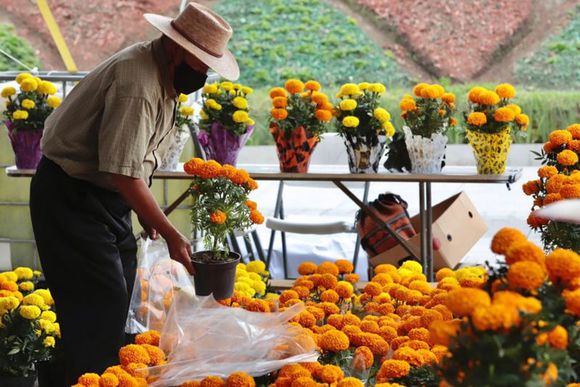MEXICO, (November 04, 2021).- The Marigold Flower is an ancestral element used to adorn the altars of the dead and aromatize the cemeteries with its enigmatic smell, but now, in the XXI century, it is expanding the markets to use it as a treatment against cancer, it was even discovered it to be edible.
A group of researchers from the Center for Research and Advanced Studies (Cinvestav) of Querétaro, seek to implement Marigold for the treatment of colon cancer.
Every year the marigold flower is used by Mexicans to commemorate loved ones who have left, but now it can also be used to solve a serious health problem.
The team led by Dr. Alejandro Manzano Ramírez, together with Dr. Flavia Loarca and Dr. Sandra Olimpia, belonging to the food postgraduate course at the Autonomous University of Querétaro, are seeking to take advantage of the “power of the flower”, typical of the Day of the Dead, as it is not only part of an ancient tradition, but also has medicinal properties.
The specialists decided to use the organic compounds and pigments of marigold to extract and reduce the gold nanoparticles, which belong to this flower, and can be used for colon cancer treatments.

The purpose of fusing the marigold compounds is to provide a substance that kills cancer cells and lowers the risk of disease-damaged cells growing.
In addition, with these investigations, the scientists intend to address this serious health problem, as well as provide other alternatives for sale to farmers in the field.
At the end of the 80s the flower was planted as an ornamental plant, but also to be used in the textile and food industry, since it is added to poultry feed to give color to their skin and the yolk of their eggs.
During that decade, its highest point of production was located, in 1985 they exceeded 16,600 hectares, while in 2020 they barely reached 1,951 hectares, according to figures from the Federal Government’s Agri-Food and Fisheries Information Service.
In those years, the plant served as raw material for making ice cream, craft beers, or pulque, as well as for obtaining natural coloring and dyeing objects and garments.

But in addition, the plant, apart from having singular cultural importance in the nation, was a significant source of income for the country because it is rich in carotenes, according to Francisco Basurto Peña, a researcher at the Institute of Biology (IB).
Carotenes are a series of chemical compounds that have pro-vitamin action and can be converted into vitamin A in the human body.
“Mexico was a leader in the production of these carotenoids; unfortunately, from this new century on we lost that market; now the producing countries are China in the first place and India in second, Mexico no longer appears in this industry ”
Francisco Basurto Peña
Enrique Arroyo, a marigold producer for six years, when he decided to help his father who had become independent and started his business.
The young man from the state of Hidalgo works chinampa with his parents and brothers; is one of the families that are dedicated to the cultivation of cempasúchil in the Caltongo area, in the Xochimilco mayor’s office of Mexico City.
The work to plant the flower starts from the first months of the year; “We make the order from the month of May, you have to deposit so that the seeds arrive to you on time”, he said.
Enrique Arroyo
In the meantime, they have to prepare the soil for later seedlings and the first seedling is transferred to a pot where it will finish blooming.
This year, thanks to the support of a government program, Enrique and his family had the resources to invest in more seeds, they managed to produce 17 thousand plants, 4 thousand more than in 2020, when due to the pandemic and the closure of pantheons the fall in sales was considerable.
To recover the flower market, Francisco Basurto pointed out that it is necessary to invest in basic science, fight markets, and link academia with production.
Source: Sipse
TYT Newsroom


